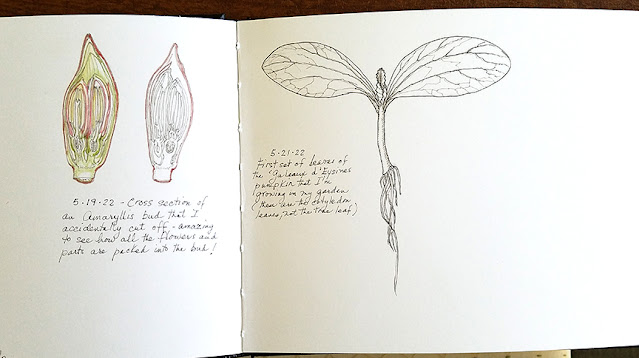 |
| Herb's bed in July |
The fullness of the season manifests itself at the height of summer, and the sequence of bloom in my garden hasn't slowed down despite the heat. Herb's bed is so colorful with the red Crocosmias, blue Centaurea, and blazing meadow stars! Several monarch butterflies showed up during the peak of bloom of the blazing meadow star (Liatris ligulistylis)--that's the most monarchs I've seen in my back yard in the decade that we've lived here.
 |
| Monarch butterfly nectaring on Liatris |
 |
| Monarch butterfly |
The monarchs flying about the garden performing their mating dances with consummate grace made for a beautiful sight! The humming birds too have been enjoying the flowers, though they have proved much more camera-shy than the butterflies. The other evening Herb and I were standing on our front porch when a tiny humming bird approached and flew within a foot of our faces--it was a female checking us out. Deciding we were probably not dangerous, she went about her business of sipping nectar from the few fragrant petunias and other plants along the front walk. The tropical salvias, one of the hummingbirds' favorites, haven't been very floriferous thus far, so there's not much to nourish them at the moment.
 |
| Coneflowers (Echinacea hybrids) and bee balm in the back bed. |
 |
| Bottlebrush buckeye (Aesculus parviflora) |
 |
| The back bed with Buddleia lindleyana in front |
The display of coneflowers in the back bed becomes more colorful every year as the plants multiply. The bottlebrush buckeye (Aesculus parviflora), another pollinator favorite, is looking better than ever; each year it expands further into its corner of the back yard.
 |
| Bush Clematis 'New Love' |
I was determined to not let the deer eat my shrub Clematis this year, and covered it with garlic spray. The spray doesn't seem to deter the deer when it comes to other tastier plants like my roses, unfortunately.
 |
| Joe Pye weed 'Baby Joe' |
 |
| Hydrangea 'Tiny Tuff Stuff' with Gladiolus |
 |
| Vitex agnus castus on the right. |
Along the east garden, the hydrangeas have fared better with a bit more rain this year than last summer. The other hydrangeas near the house are about finished blooming, except for the variety 'Tiny Tuff Stuff' above. The Vitex shrub is displaying its purple flowers that look like a summer-blooming lilac.
 |
| Caladiums on the porch |
This spring I bought an assortment of Caladium bulbs for the porch which are doing very well--love the different colors and patterns! These remind me of the shady patios of the houses in Cuba during my childhood.
 |
| Hanging basket on porch |
The hanging baskets on the porch haven't been as successful--I'd envisioned the baskets lush with tiny tomatoes, herbs and flowers by this time, but the Nasturtiums (they have edible flowers) have grown way too much and the flowers and herbs not enough. The one above is the better looking of the two, but the plants still haven't grown enough to cover the coconut fiber of the containers.
A couple of weeks ago I noticed several of my arborvitae--the two flanking the house and one of the "Little Indians" were dying back and discovered that they were heavily infested with bagworms--I've never seen such a concentration of these insects before!
The two arborvitae flanking the house are huge--about twelve to thirteen feet high--an impossible job for Herb and I to tackle. I was fortunate to find an arborist in the area who came to spray for the bagworms right away. I hope the problem has been taken care of in time to help the trees survive!
 |
| Male pumpkin flowers |
 |
| More male pumpkin flowers |
This summer I've been growing an heirloom pumpkin vine, 'Galeaux d'Eysines,' in order to see what the vine and flowers looked like. I wanted to add these to my painting of the pumpkin that I started last fall. It's fascinating to learn that pumpkins have male and female flowers, and that although they appear similar on the surface, they are easily distinguishable: the males have one large structure in the center that carries the pollen, while the female buds have an ovary that looks like a tiny pumpkin at their base. Inside, the pistil divides into three lobes.
 |
| Female pumpkin flower bud |
 |
| Female pumpkin flower |
 |
| Pumpkin developing on the vine. |
Nature always allocates its resources wisely, so the male flowers outnumber the females by a ratio of about ten or twelve to one--I expect to have maybe one to three mature pumpkins at the end of the growing season, unless something eats or finishes them off before harvest time. I'll be finished with my painting by then, and it would be nice to be able to taste the pumpkin--last fall when I bought the warty "peanut" pumpkin it took me a couple of months to paint it, and by that time the pumpkin wasn't very appetizing. I cooked it and used the pulp to bake some pumpkin bread, but it would be nice to be able to taste the flesh when it is fresh. I understand it's delicious!
 |
| My unfinished painting of the Galeaux d'Eysines pumpkin. |













































